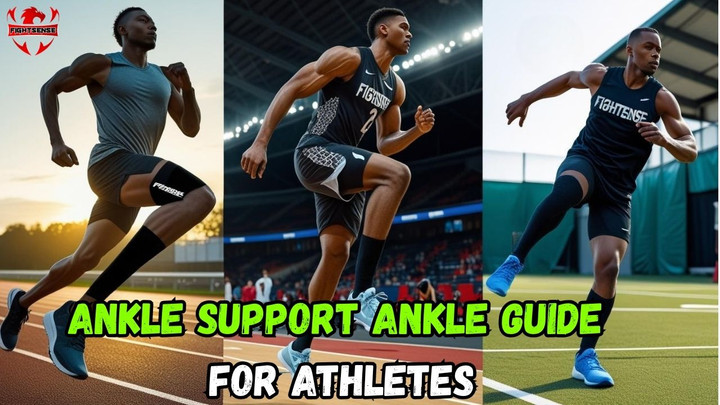The Ultimate 2025 Ankle Support Ankle Guide for Athletes
23rd Jul 2025
When it comes to physical activities, ensuring your body is well-supported is essential. One of the most common and crucial forms of support is ankle support. Whether you're making sharp movements or engaging in high-impact activities, proper support can make all the difference in preventing injuries and enhancing performance. In this blog, we'll explore the importance of ankle support ankle, its benefits, and how to choose the right support for your needs.
Key Highlights
- Ankle support is essential for preventing injuries in sports like basketball and running.
- The right ankle support ankle provides stability and enhances performance.
- Ankle support for basketball often involves high-top shoes and additional braces for extra protection.
- Runners benefit from ankle support that reduces impact and strain during runs.
- Choose ankle support based on your sport, activity level, and comfort preferences.
Why Ankle Support Ankle Matters
The ankle is one of the most frequently injured joints in sports. From sprains to strains, ankle injuries can sideline athletes for weeks, or even longer, making effective support crucial for both injury prevention and recovery.
A well-designed ankle support provides stability to the joint, helps protect ligaments and tendons, and ensures that the ankle remains properly aligned during movement. This is why ankle support is a vital part of any athlete’s gear, regardless of the sport they participate in.
Ankle Support: Important for Performance and Avoiding Injuries
Ankle Support Basketball
- Intensive biomechanical demands: In basketball, the rapid directional changes, explosive jumps, and abrupt pivots place substantial strain on the ankle joint.
- Injury mitigation: Optimal ankle support, such as high-top footwear or specialized ankle braces, can significantly reduce the likelihood of sprains and ligament strains by enhancing stability.
- Stabilization role: Ankle supports act to secure the joint, preventing lateral or rotational movements that could lead to injuries, thus ensuring greater safety and elevated performance during high-intensity court movements.
Ankle Support for Running
- Cumulative impact: Running, particularly long-distance running, subjects the ankle joint to continuous repetitive stress, leading to the potential for overuse injuries, including tendinitis or stress fractures.
- Compression therapy: Lightweight compression sleeves or ankle braces help dissipate the forces transferred to the ankle, thereby minimizing stress and preventing degenerative injuries.
- Performance optimization: The application of appropriate ankle support promotes enhanced comfort and stability, allowing runners to maintain peak performance levels throughout extended sessions or competitive events.
Sports Ankle Support: Indispensable for Every Athlete
- Protective necessity across disciplines: Regardless of the sport—be it soccer, tennis, or other dynamic activities—sports ankle support is integral in safeguarding the joint against both overuse injuries and acute trauma resulting from sudden movements.
- Diverse support mechanisms: Ankle supports are available in various forms, such as rigid braces, flexible wraps, and compression sleeves, offering different levels of protection, tailored to the specific demands of each sport.
- Tailored support selection: The choice of ankle support should align with the intensity and nature of the sport. High-mobility activities require more robust ankle support to shield the joints from excessive strain and ensure optimal performance under pressure.
How to Pick the Best Ankle Support for Safety
Q1: What fit should ankle support have?
Ankle support should fit snugly, without being too tight, to ensure proper protection.
Q2: What activity level should you consider when choosing ankle support?
For high-impact sports like basketball, choose rigid support. Runners may prefer lighter, flexible sleeves. FightSense offers options for both types of activities.
Q3: What material is best for ankle support?
Look for breathable, moisture-wicking materials to ensure comfort.
Q4: How durable should ankle support be?
Ankle support should be able to withstand the demands of your sport and offer long-lasting protection.
Q5: When should I wear ankle support?
Ankle support should be worn during activities that put strain on the joint, such as running or intense sports.
Q6: Can ankle support help with recovery?
Yes, ankle support can aid in recovery by providing stability and reducing stress on the joint during rest periods.
Q7: Can I wear ankle support all day?
It's best to wear ankle support during physical activity. Wearing it continuously can cause discomfort or restrict blood flow.
Conclusion
Incorporating proper ankle support ankle into your training and performance routine is a wise choice for any athlete. Whether you're playing basketball, running, or participating in other sports, ankle support plays a key role in injury prevention and performance enhancement. The right support can help you stay active, recover faster, and perform better without the fear of ankle injuries slowing you down.
Disclaimer: The content provided in this blog is for informational purposes only. Always consult with a healthcare professional before using any form of ankle support, especially if you have pre-existing injuries or conditions.

